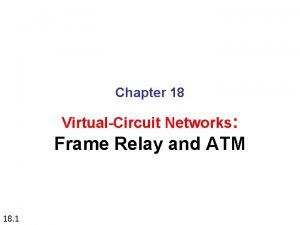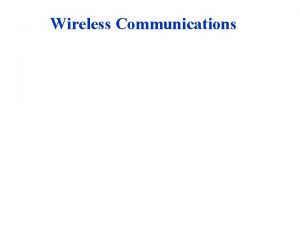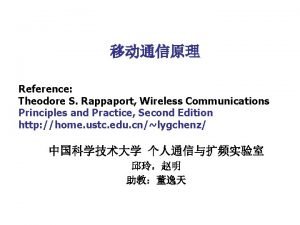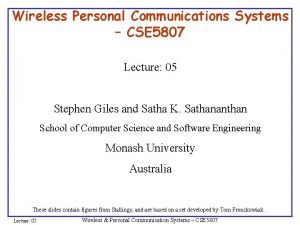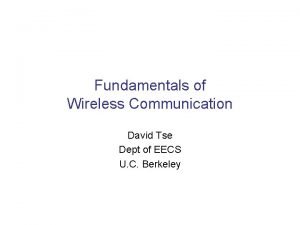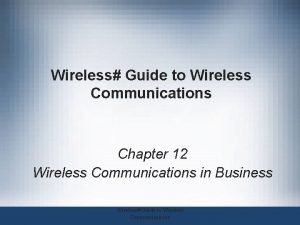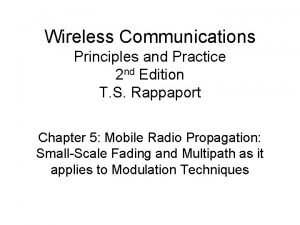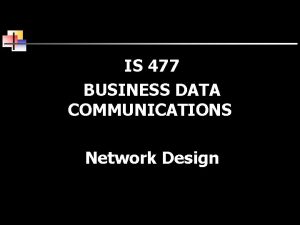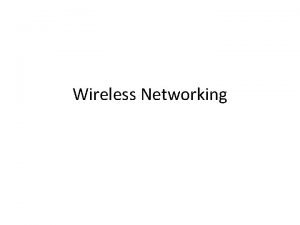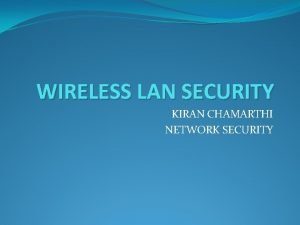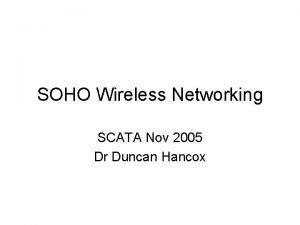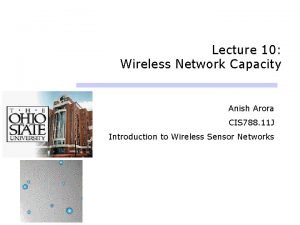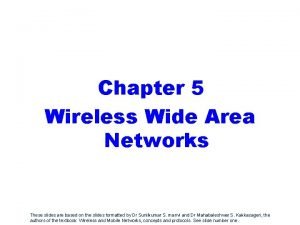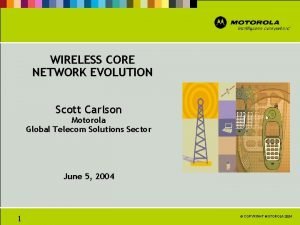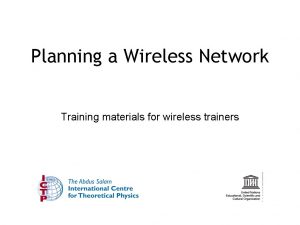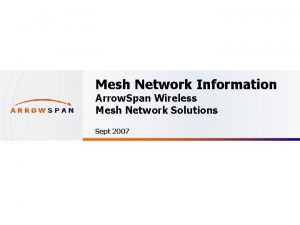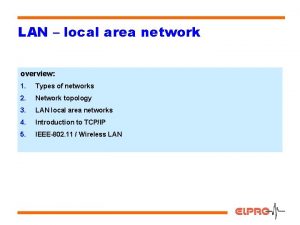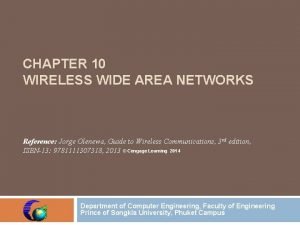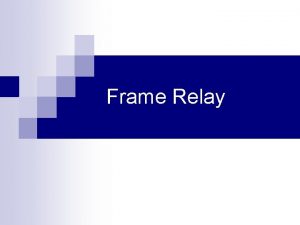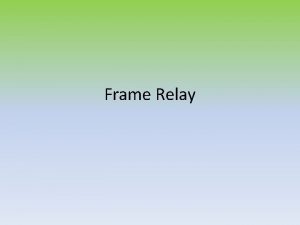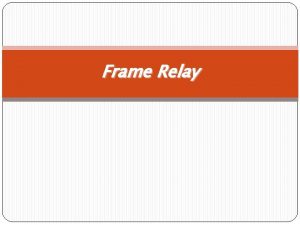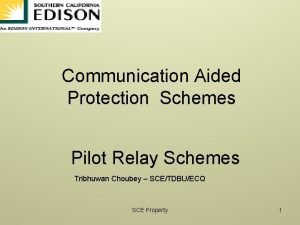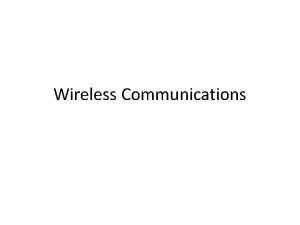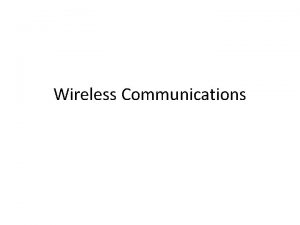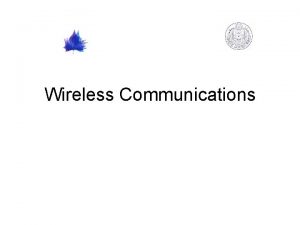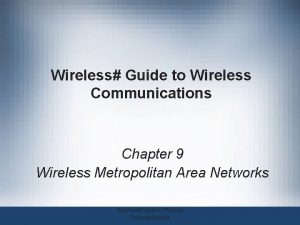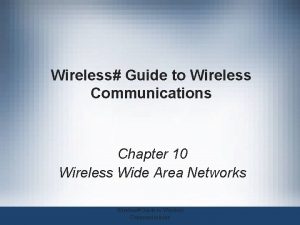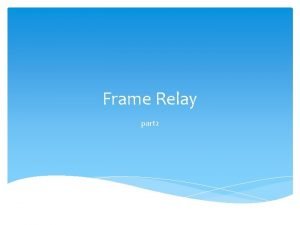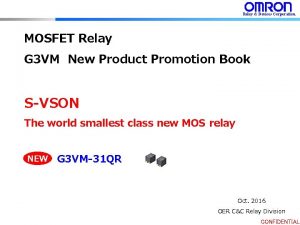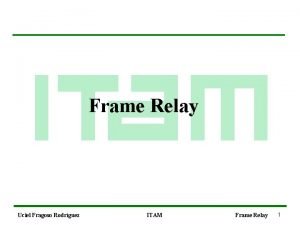AmplifyandForward Schemes for Wireless Communications Wireless Relay Network


























- Slides: 26

Amplify-and-Forward Schemes for Wireless Communications

Wireless Relay Network Fixed channel s t The network is the channel “Tunable” channel s Problem: Design the optimal channel t 2

Relay Networks: Advantages Enhanced coverage Increased throughput Resilient communication 3

Wireless Relay Networks Source Receiver Noise Interference Synchronization Channel Parameters Challenge: Low complexity communication schemes for Wireless relay Networks 4

Three Candidates A: DNC “Noisy” Network Coding B: PNC Amplify-and-forward C: Quantize-map-and-forward

“Noisy” Network coding n Alice A single link: ⁞ ⁞ 111 α β 101 001 …… Overall network bit-error ~Ber(p) No more than p. Emn 1 s (Worst-case) Bob 110 101 011 ……

“Noisy” Network coding: Bounds TX(1) TX(2) 2 p. Emn TX(3) p. Emn 2 p. Emn For both coherent & incoherent NC Q. Wang, S. Jaggi, S. -Y. R. Li. Binary error correcting network codes. In Proc. ITW 2011.

Amplify-and-Forward Relaying 9

Amplify-and-Forward in Wireless Networks “Intersymbol Interference Channel with Colored Gaussian Noise” s t 10

Achievable Rate for AF Relay Networks Lemma (Achievable rate for AF relay network): For an AF-relay network with M nodes, the rate achievable with a given amplification vector β is Maximum Achievable rate: 11

Part I: Approximating IAF(Ps) Computing IAF(Ps) is ``hard’’ Relay without Delay Approximation: In some scenarios, almost optimal performance Lower-bound within a constant gap from cutset upper-bound S. Agnihotri, S. Jaggi, M. Chen. Amplify-and-forward in wireless relay networks. In Proc. ITW 2011. 12

Layered Wireless Networks “No Intersymbol Interference, White Gaussian Noise” s t 13

AF Rate in Layered Networks Previous Work – High SNR – Max. Transmit Power – Few layers Our Work – Arbitrary SNR – Optimal Transmit Power – Any number of layers Function of βli 14

Part II: Computing Lemma (Computing Optimal β): can be computed layer-by-layer - maximize the sum rate to the next layer - exponential reduction in the search space: NL L N The optimal AF rates for s t Equal channel gains along all links between two adjacent layers S. Agnihotri, S. Jaggi, M. Chen. Analog network coding in general SNR regime. To appear in ISIT 2012. 15

Part III: A Greedy Scheme - The optimal AF rate for the Diamond Network s t - First analytical characterization The optimal AF rates for s t Equal channel gains along all outgoing links from every node For general layered networks: better rate approximation S. Agnihotri, S. Jaggi, M. Chen. Analog network coding in general SNR regime: performance of a greedy scheme. To appear in Net. Cod 2012. 16

Part IV: Network Simplification What fraction of the optimal rate can be maintained by using k out of N relays in each layer? Diamond Network: s t RN – Rk = log(N/k) RN/Rk = N/k ECGAL Network: s t RN – Rk = 2 L log(N/k) RN/Rk = (N/k)2 L-1 S. Agnihotri, S. Jaggi, M. Chen. Analog network coding in general SNR regime: performance of network simplification. Submitted to ITW 2012. 17

Project Outcome So Far New fundamental results for layered AF-networks: many firsts New insights useful for: • characterization of the optimal rate in general AF networks • design of the optimal relay scheme for layered networks 18

Communication over a point-to-point channel is an integerand we take its binary representation . . . = 42 3 19 9 . . . . 190 = = 5 = 1 0 0 1 1 09 0 1 0 0 1 = 1 42 = = = 0 1 0 03 0 0 0 1 1 = = 6 50 5 0 4 0 3 1 2 0 1 1

Communication over a point-to-point channel is an integerand we take its binary representation . . . 0 0 1 = = 1 0 1 0 0 0 1 1 = 0 1 0 0 1 1 = 0 0 0 1 = 6 5 4 3 2 1 5 42 . . . 3 19 9 . . . . 6 5 4 3 2 1 0 0 1 0 1 1 0 0 0 0 . . . . Bit flips 0 1 0 0 0 1 1

Communication over a point-to-point channel is an integerand we take its binary representation . . . 0 0 1 = = 1 0 1 0 0 0 1 1 = 0 1 0 0 1 1 = 0 0 0 1 = 6 5 4 3 2 1 5 42 . . . 3 19 9 . . . . 6 5 4 3 2 1 0 0 1 0 1 1 0 0 0 0 . . . . Bit flips 0 1 0 0 0 1 1

Communication over a point-to-point channel is an integerand we take its binary representation Dependent bit flips . . . 0 0 1 = = 1 0 1 0 0 0 1 1 = 0 1 0 0 1 1 = 0 0 0 1 = 6 5 4 3 2 1 5 42 . . . 3 19 9 . . . . 6 5 4 3 2 1 0 0 1 0 1 1 0 0 0 0 . . . . Bit flips 1 1 0 0 0 1 1

Communication over a point-to-point channel is an integerand we take its binary representation Dependent bit flips . . . = 0 0 1 1 5 42 3 19 9 . . . . Very noisy bit levels 6 5 4 3 2 1 0 0 1 0 1 1 0 0 0 0 . . . . Bit flips 1 1 0 0 0 1 1 Less noisy bit levels 0 0 1 = 1 0 1 0 = 0 1 0 0 1 1 = 0 0 0 1 = 6 5 4 3 2 1 . . .

Communication over a point-to-point channel T. Dikaliotis, H. Yao, A. S. Avestimehr, S. Jaggi, T. Ho. Low-Complexity Near-Optimal Codes for Gaussian Relay Networks. In SPCOM 2012. is an integerand we take its binary representation . . . = 0 0 1 1 5 42 3 19 9 . . . . Very noisy bit levels . . . 6 5 4 3 2 1 0 0 1 0 1 1 0 0 0 0 . . . . Bit flips 1 1 0 0 0 1 1 Less noisy bit levels 0 0 1 = 1 0 1 0 = 0 1 0 0 1 1 = 0 0 0 1 = 6 5 4 3 2 1 Code to correct adversarial errors

Publications 1. S. Agnihotri, S. Jaggi, M. Chen. Amplify-and-forward in wireless relay networks. In Proc. ITW 2011. 2. Q. Wang, S. Jaggi, S. -Y. R. Li. Binary error correcting network codes. In Proc. ITW 2011. 3. S. Agnihotri, S. Jaggi, M. Chen. Analog network coding in general SNR regime. To appear in ISIT 2012. 4. S. Agnihotri, S. Jaggi, M. Chen. Analog network coding in general SNR regime: performance of a greedy scheme. To appear in Net. Cod 2012. 5. S. Agnihotri, S. Jaggi, M. Chen. Analog network coding in general SNR regime: performance of network simplification. To appear in ITW 2012. 6. T. Dikaliotis, H. Yao, A. S. Avestimehr, S. Jaggi, T. Ho. Low-Complexity Near-Optimal Codes for Gaussian Relay Networks. To appear in SPCOM 2012. 7. S. Agnihotri, S. Jaggi, M. Chen. Analog network coding in general SNR regime. In preparation for submission to Trans. Info. Theory. 25

Current and Future Work Optimal and efficient relay schemes for layered networks Distributed relay schemes “Back to general AF networks” - the optimal rate, distributed schemes General wireless relay networks - resource-performance tradeoff - optimal relay scheme, capacity Incorporating “simple” error-correction “The capacity of relay channel” 26

Thank You 27
 Atm frame size
Atm frame size Guide to wireless communications 4th edition
Guide to wireless communications 4th edition Andrea goldsmith wireless communications
Andrea goldsmith wireless communications Subsea wireless communications
Subsea wireless communications Theodore s rappaport wireless communications
Theodore s rappaport wireless communications Cse
Cse Fundamentals of wireless communication solution
Fundamentals of wireless communication solution Guide to wireless communications
Guide to wireless communications Sircim
Sircim What are wireless devices and the wireless revolution
What are wireless devices and the wireless revolution Communications network design
Communications network design Chapter 3 network protocols and communications
Chapter 3 network protocols and communications Wireless network definition
Wireless network definition Wlan network
Wlan network Soho network definition
Soho network definition Wireless security in cryptography and network security
Wireless security in cryptography and network security Receiver sensitivity
Receiver sensitivity Wireless sensor network protocols
Wireless sensor network protocols Wireless wide area networks
Wireless wide area networks Dilbert wireless network
Dilbert wireless network Planning a wireless network
Planning a wireless network Outdoor wireless mesh network design
Outdoor wireless mesh network design Lan type a
Lan type a Telosb
Telosb Wireless wide area network
Wireless wide area network Wireless network management software
Wireless network management software Wireless network components
Wireless network components
